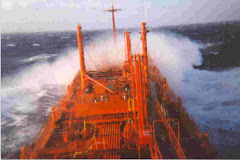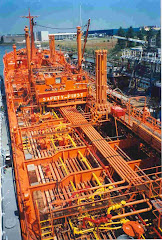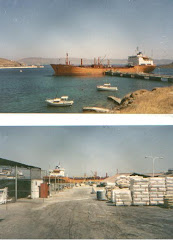Gerry Wang, Seaspan’s ebullient CEO, frequently refers to his business model as a ‘leasing” operation. I have long questioned this. In fact, Seaspan is a conventional vessel provider to liner companies. Their contractual relations are long-term time charters with performance risk. Yet this latest deal to order 14.000 TEU mega-ships and then charter them to Yang Ming Transport Corporation for their liner service has many interesting parallels to the ship leasing business that are illustrative of the business risks and rewards in the Seaspan business strategy.
Yang Ming recently announced consecutive losses TWD 2.6 billion (US$ 87 million) in the 2nd quarter 2013 earnings conference. Revenue for the quarter was TWD 30 billion, a year-on-year decline of 14%, but a small quarter-on-quarter bounce of 9%. The poor performance was blamed on depressed freight rates for the Asia-to-Europe trade lane from which Yang Ming derived about 27% of its revenue in 2012.
Yang Ming suffers from an over-leveraged balance sheet with too much debt and is struggling to shed assets for liquidity by selling off terminal operations and leasing them back.
Consequently, they are in no position to contract 14.000 containerships. So they have now entered into an agreement to charter in ten additional 14,000-teu containerships from Seaspan, which are slated for delivery in 2015-16. The logic is the usual in this business of ever-declining margins and over capacity: “These mega vessels are expected to be deployed on the Asia-Europe route and are expected to bring unit costs to down better complement the fleet of the CKYH alliance,” according to Jon Windham, a Barclay analyst covering them.
Seaspan initially ordered speculatively these mega-ships, paying US$ 110 million per unit at Hyundai Heavy Industries. With ten new units now committed to Yang Ming, Seaspan is now turning to Taiwan’s CSBC Corporation for five additional 14,000-teu vessels on the same price terms as the earlier Hyundai order as an added sweetener to this Taiwan deal.
No doubt, Seapan is offering Yang Ming a considerable service with these units that they could not afford to contract themselves. Yang Ming is paying them a rate of US$ 46.000 per day upon delivery for the next ten years.
All this, however, cannot eradicate the bare facts that Seaspan is openly speculating in assets against charters often to financially weak liner companies in an industry that is suffering chronic overcapacity. They wagering on an eventual cyclical market turn-around with increased box traffic. Yet the heavy ordering of megaships contributes to over capacity. Unless there is real turn around in terms of increased container traffic and demand for box slots, this almost resembles a Ponzi scheme.
Of course, nobody can deny the tenacity of Gerry Wang and business standing of Seaspan in the liner industry. Greek-listed container vessel companies like Danaos, Box Ships and Diana containers pale in comparison as poor relatives and much weaker management teams.
The only really strong and healthy listed Greek containership company is Costamare, whose largest vessels are 9.000 TEU. They have a history of sustained profitability and they have not rushed into the megaships. Many of their units are employed in feeder services, which are a growing and generally profitable subsector due larger ships on head haul routes, use of hub ports and increasing demand for distribution of boxes to smaller ports.
The business risks for Seaspan are similar to finance leasing companies in their business of high cost finance generally to a clientele of financially weaker shipping companies. Sometimes the companies have liquidity problems and are looking to sell assets and lease them back. Other times, they are expanding rapidly and have exhausted conventional lower cost bank finance. The leasing companies bet on company turnaround and stronger markets to prop up their financially weak clients.
Seaspan’s prime universe for these mega-ships is financially weak liner companies without the resources to order directly the vessels themselves. Success of the venture depends critically on a market turn around. Should this growth even finally level off with Far East trade rebalancing and slow recovery in Western economies leading to a belated and major shakeup in the Liner industry with few companies, some major bankruptcies, etc., then Seaspan might find itself badly exposed with such aggressive ordering.
So far Seaspan has managed to weather well the shock back in 2008 without a single order cancellation and is continuing its aggressive growth.
Yang Ming recently announced consecutive losses TWD 2.6 billion (US$ 87 million) in the 2nd quarter 2013 earnings conference. Revenue for the quarter was TWD 30 billion, a year-on-year decline of 14%, but a small quarter-on-quarter bounce of 9%. The poor performance was blamed on depressed freight rates for the Asia-to-Europe trade lane from which Yang Ming derived about 27% of its revenue in 2012.
Yang Ming suffers from an over-leveraged balance sheet with too much debt and is struggling to shed assets for liquidity by selling off terminal operations and leasing them back.
Consequently, they are in no position to contract 14.000 containerships. So they have now entered into an agreement to charter in ten additional 14,000-teu containerships from Seaspan, which are slated for delivery in 2015-16. The logic is the usual in this business of ever-declining margins and over capacity: “These mega vessels are expected to be deployed on the Asia-Europe route and are expected to bring unit costs to down better complement the fleet of the CKYH alliance,” according to Jon Windham, a Barclay analyst covering them.
Seaspan initially ordered speculatively these mega-ships, paying US$ 110 million per unit at Hyundai Heavy Industries. With ten new units now committed to Yang Ming, Seaspan is now turning to Taiwan’s CSBC Corporation for five additional 14,000-teu vessels on the same price terms as the earlier Hyundai order as an added sweetener to this Taiwan deal.
No doubt, Seapan is offering Yang Ming a considerable service with these units that they could not afford to contract themselves. Yang Ming is paying them a rate of US$ 46.000 per day upon delivery for the next ten years.
All this, however, cannot eradicate the bare facts that Seaspan is openly speculating in assets against charters often to financially weak liner companies in an industry that is suffering chronic overcapacity. They wagering on an eventual cyclical market turn-around with increased box traffic. Yet the heavy ordering of megaships contributes to over capacity. Unless there is real turn around in terms of increased container traffic and demand for box slots, this almost resembles a Ponzi scheme.
Of course, nobody can deny the tenacity of Gerry Wang and business standing of Seaspan in the liner industry. Greek-listed container vessel companies like Danaos, Box Ships and Diana containers pale in comparison as poor relatives and much weaker management teams.
The only really strong and healthy listed Greek containership company is Costamare, whose largest vessels are 9.000 TEU. They have a history of sustained profitability and they have not rushed into the megaships. Many of their units are employed in feeder services, which are a growing and generally profitable subsector due larger ships on head haul routes, use of hub ports and increasing demand for distribution of boxes to smaller ports.
The business risks for Seaspan are similar to finance leasing companies in their business of high cost finance generally to a clientele of financially weaker shipping companies. Sometimes the companies have liquidity problems and are looking to sell assets and lease them back. Other times, they are expanding rapidly and have exhausted conventional lower cost bank finance. The leasing companies bet on company turnaround and stronger markets to prop up their financially weak clients.
Seaspan’s prime universe for these mega-ships is financially weak liner companies without the resources to order directly the vessels themselves. Success of the venture depends critically on a market turn around. Should this growth even finally level off with Far East trade rebalancing and slow recovery in Western economies leading to a belated and major shakeup in the Liner industry with few companies, some major bankruptcies, etc., then Seaspan might find itself badly exposed with such aggressive ordering.
So far Seaspan has managed to weather well the shock back in 2008 without a single order cancellation and is continuing its aggressive growth.









